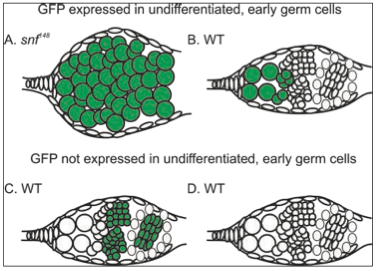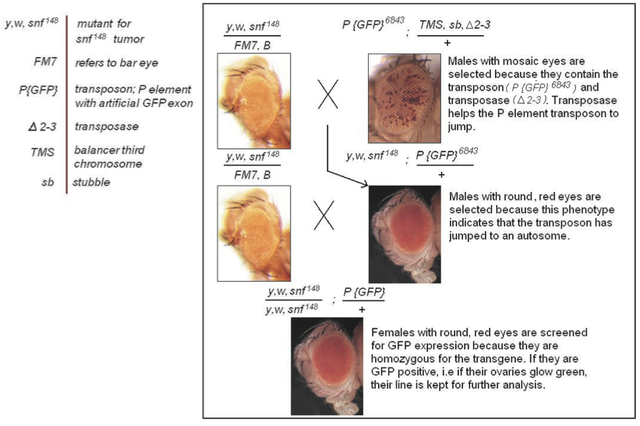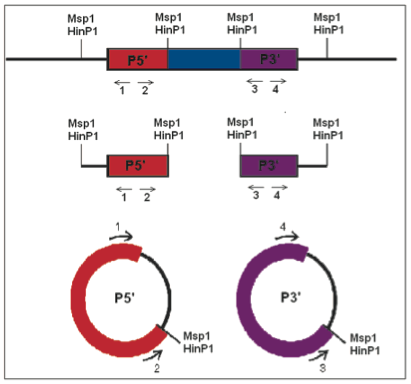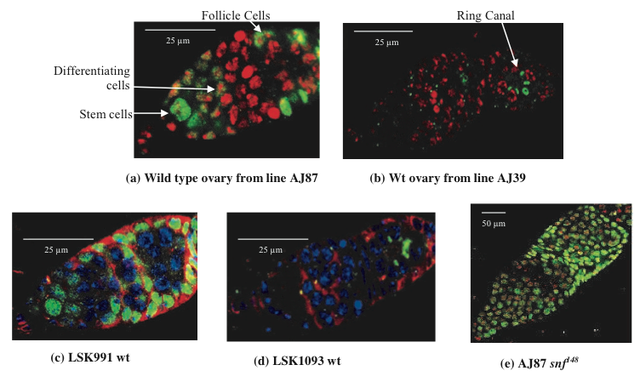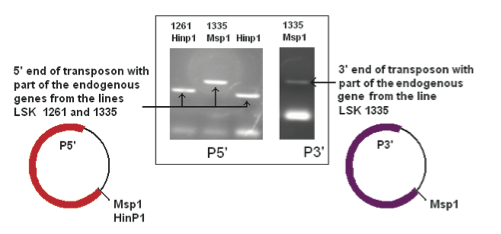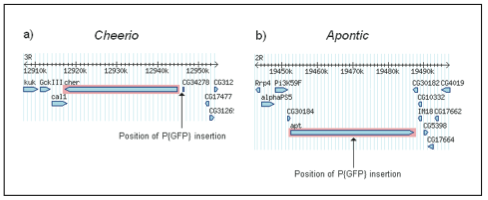From Discussions VOL. 5 NO. 1A Genome Wide Search for Proteins that Control the Balance Between Proliferation and Differentiation in the Drosophila Ovary, an in vivo model SystemMATERIALS AND METHODSUnfixed, dissected ovaries were screened directly for naturally fluorescent GFP expression. The ovaries were from females containing the P{GFP} insertion. Possible expression patterns that could have been detected are shown below (Fig. 3, provided by Johnie Chau). Figure 3. Possible GFP expression patterns. A) snf148 ovaries were screened for GFP expression throughout the germline. B-D) Expression patterns that could have been detected in wild type ovaries are B) expression in undifferentiated, early germ cells, C) expression in differentiated cells and D) no expression in the germline.
To generate lines containing a single GFP insertion, different genotypes of flies were selected and mated based on eye color and shape until females with the insertion were obtained. First, males containing the P{GFP} transposon and transposase were mated to females homozygous for snf148. Progeny in which the transposon had jumped to an autosome were then selected and mated to homozygous snf148 females. Finally, females with the insertion were selected and screened for GFP expression. The screen is shown to the right in a figure created by the author. Once a line expressing GFP was identified, the line was expanded to obtain a sufficient number of flies for confocal microscopy and inverse PCR. Confocal Microscopy10 wild type flies and 10 mutants were selected from each GFP positive line in order to compare expression in wild type and tumorous ovaries. A three day antibody staining procedure with rabbit anti-GFP was applied to increase GFP expression for easier identification of expression patterns in the ovary. Slides were prepared by teasing apart the ovarioles and fixing them in Vectashield Mounting Medium. High resolution microscopy was then used to capture images of GFP expression in the ovarioles. Inverse PCRTo locate the protein-trap insertion, the DNA flanking the insertion was recovered and sequenced using inverse PCR. The process of inverse PCR is shown in figure 5 (next page), provided by Johnie Chau. DNA was extracted from 30 mutants per line by treating them with buffer, a LiCl/KAc solution and TE. Then the DNA was digested with restriction enzymes HinP1 and Msp1. The transposon was ligated to the endogenous DNA using ligation buffer and T4 Ligase. Finally, inverse PCR was performed with Pwht1 and Plac1 as 5' primers and Pry4 and Pry1 as 3' primers. Figure 4. The GFP Screen
Gel ElectrophoresisThis procedure was used to determine if the PCR products would be sufficient for obtaining good sequencing results. A 1.2% agarose gel was used to run the samples and the 100 bp marker. BLASTBy analyzing the sequencing results, the endogenous gene was identified by its presence between the P{GFP} transposon and the restriction site. BLAST alignments were performed on the endogenous sequence and the Drosophila genome to identify the location of the insertion within the genome. Figure 5. Inverse PCR. 1. Genomic DNA from a P{GFP} line is digested with restriction enzyme MspI or HinPI. 2. Fragments are made to self-ligate using T4 ligase. 3. 1-4 listed by the small arrows are the primers; red and purple bars represent ends of the transposon; black line represents endogenous DNA sequence.
RESULTSConfocal MicroscopyShown to the right are high resolution pictures of lines that were used (Figure 6). Figure 6. Confocal Imaging a) Wild type ovary from line AJ87. GFP expression is seen in the stem cells in the germarium, and in the follicle cells, b) Wt ovary from line AJ39. GFP expression is seen in ring canals, the region where interconnected germ cells connect, c) Wt ovary from LSK991. GFP expression is seen in the stem cells and follicle cells, d) Wt ovary from LSK1093. GFP expression is seen in the ring canals, e) Tumorous ovary from AJ87. Strong GFP expression is seen throughout the ovary. In (a), (b) and (e), DNA is colored red and GFP is green. In (c) and (d), DNA is colored blue and GFP is green, and 1B1 antibody causes the red color.
Inverse PCR and Gel electrophoresisShown to the right are results from the inverse PCR of lines LSK 1261 and 1335 (Figure 7). The products are different in size because they were digested with different restriction enzymes, either Msp1 or HinP1. Figure 7. Inverse PCR. On the left are results obtained from 5' PCR primers Wht1 and Plac1. On the right are results from 3' PCR primers Pry4 and Pry1. The bright bands at the bottom of the gel are most likely primer dimers.
BLASTSequencing results from PCR products showed the location of the transposon and the restriction site, whose sequences are known. In between the two was the sequence of the endogenous gene. Aligning the endogenous gene with the Drosophila genome showed us the approximate location of the gene within the genome. The 5' PCR product of LSK1093 digested with Msp1 aligned with a region outside the 5' region of the ̳Cheerio' gene. The 5' product of LSK991 digested with HinP1 aligned with part of the sequence of the ̳Apontic' gene. The approximate locations of the P element insertions are shown above (Figure 8).
Figure 8. Location of the endogenous gene. A) from line LSK1093, digested with Msp1 B) from line LSK991, digested with HinP1.
In the mutant AJ87, GFP expression was seen throughout the ovary (Figure 6), in the stem cell-like cells arrested in an intermediate stage of development. This may show that the ̳trapped' protein is involved in arresting differentiation and restarting proliferation. GFP expression was seen in proliferating germ cells in the AJ87 and LSK991 wild types, which may show that the trapped protein has a role in early germ cell proliferation. Although the intention of the screening was to identify expression in proliferating cells, expression was unexpectedly found in ring canals in AJ39 and LSK 1093. Ring canals are cytoplasmic bridges that allow the flow of nutrients from nurse cells to oocytes. They are necessary for proper oocyte and egg chamber formation (Robinson D.N, Cant, K and Cooley, L., 1994). Therefore, expression in the ring canals may show that the trapped protein is involved in differentiation and proper cell development. In LSK991, the GFP insertion occurred in Apontic, which is thought to be involved in transcriptional activity, mRNA binding and DNA binding. This gene may not be directly involved in stem cell proliferation. Cheerio is known to be involved in ring canal formation, but ring canals may only be required for proper differentiation and not for making the transition between proliferation and differentiation. Therefore, Cheerio may not have a direct role in controlling the balance between proliferation and differentiation. Sequencing of lines AJ87 and AJ 39 is currently in progress, and it will be interesting to see if the insertions occurred in Cheerio and Apontic, as the expression patterns in AJ87 and AJ39 are consistent with LSK991 and LSK1093 respectively. The goal was to find genes that are highly expressed in tumor cells and may play a role in the stem cell's decision to proliferate or differentiate. In all four lines, GFP was highly expressed in tumor cells, and looking at expression patterns in the wild type offered a clue as to what type of role the trapped protein may have. Further analysis to determine the identity of the trapped proteins will lay the groundwork for understanding their role in the pathway that controls the choice between proliferation and differentiation. AcknowledgementsI would like to thank L.S. Kulnane for her help in conducting the screen and collecting data, J. Chau and M.L. Johnson for figures and helpful discussions, and H.K Salz for introducing me to this project and mentoring. ReferencesBuszcak M, Paterno S, Lighthouse D, Bachman J, Planck J, et al. (2007). The Carnegie protein trap library; a versatile tool for Drosophila developmental studies. Genetics 175: 1505-1531. Morin, X., R. Daneman, M. Zavortink, and W. Chia. 2001. A protein trap strategy to detect GFP-tagged proteins expressed from their endogenous loci in Drosophila. PNAS 98, 15050-15055. Robinson, D.N., Cant, K. and Cooley, L. (1994). Morphogenesis of Drosophila ovarian ring canals. Development 120, 2015-2025. Suggested Reading from Inquiries Journal
Inquiries Journal provides undergraduate and graduate students around the world a platform for the wide dissemination of academic work over a range of core disciplines. Representing the work of students from hundreds of institutions around the globe, Inquiries Journal's large database of academic articles is completely free. Learn more | Blog | Submit Latest in Biology |

